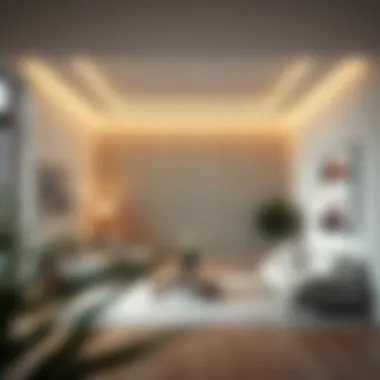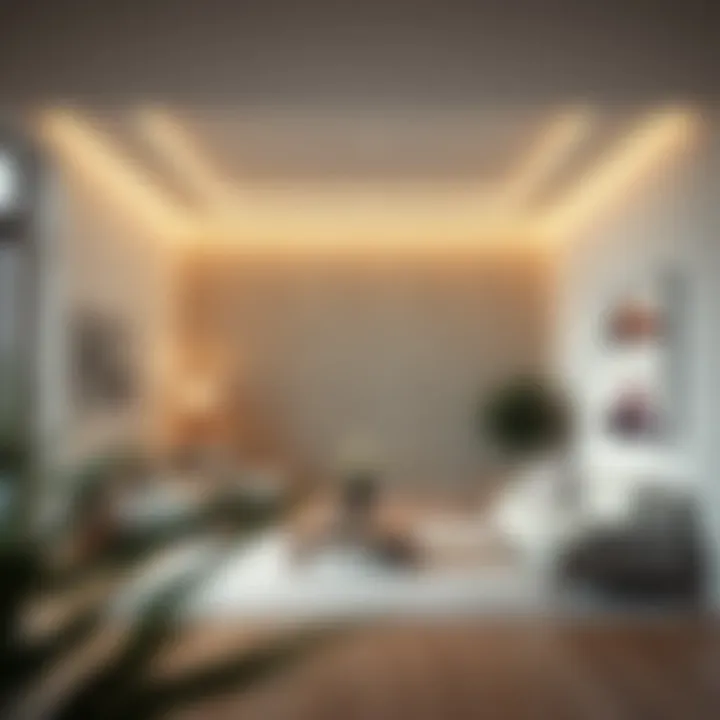Calculating Room Area: Techniques and Insights


Intro
Calculating the area of a room may seem simple at first glance, yet it is a skill that holds vast importance in various fields such as interior design, real estate, and even renovation projects. Getting the area right not only helps in determining the amount of flooring or paint required, but also plays a pivotal role in enhancing the overall aesthetic and functionality of the space. As interest in home improvement rises, understanding how to accurately compute the area of various room shapes becomes essential for homebuyers, renters, and design enthusiasts alike.
This article aims to dissect the methodologies behind room area calculation, exploring standard procedures and diving into unique shapes that often require unconventional thinking. Throughout, readers will find useful tips and techniques to apply in their own spaces, allowing them to make informed decisions that can potentially elevate their living or working environments. Whether you’re a first-time homebuyer ready to measure your new space or an experienced designer laying out a plan for an intricate project, this guide will equip you with the necessary tools and knowledge.
In the journey ahead, we shall delve into key aspects of room area calculation, emphasizing the relevance of different shapes, measurement devices, and practical applications in everyday design and planning.
Prolusion to Area Calculation
Grasping the fundamentals of area calculation is essential, especially when it comes to spaces we inhabit or design. This knowledge isn't just for mathematicians or architects. It's woven into the fabric of everyday decision-making in real estate, interior design, and even home improvement. Accurately determining the area of a room impacts everything from furniture placement to property valuation.
With the right calculation techniques, a homeowner can make informed decisions on renovations, while potential buyers can assess whether a property meets their needs without feeling like they're flying blind. In this article, we aim to illuminate these procedures, allowing readers to move confidently in their decisions involving spatial dimensions.
Significance of Area Measurements
Area measurements serve a critical purpose in multiple spheres of life. For instance, knowing the square footage of a room can dictate whether a family can comfortably fit their belongings or if a home office is large enough for essential equipment. Here's why these measurements carry such weight:
- Space Utilization: Efficient use of space is crucial. Understanding area lets individuals arrange and utilize their environments effectively. A well-measured living room can become a multifunctional area, hosting both conversations and activities without feeling cramped.
- Financial Implications: In real estate, area measurements play a direct role in valuation. Bigger often means costlier, but the practical understanding of area helps buyers determine value fairly. A home with more usable square footage can warrant a higher price.
- Health and Safety: Building codes may depend on area calculations for things like ventilation or emergency exits. Knowing the area can ensure adequate safety compliance.
In sum, whether you're rearranging furniture or making a major purchase, accurate area measurements fine-tune your understanding and help avoid costly mistakes.
Common Applications in Real Estate and Design
The applications of area calculations extend far and wide, spanning various fields, notably real estate and design. Here’s how area measurements shape these industries:
- Home Buying and Selling: Real estate agents highlight square footage prominently in listings. Buyers rely on these numbers to evaluate spaces against their needs. It's like reading a map; you need to know the terrain before venturing into unfamiliar territory.
- Interior Design: Designers use area measurements to create aesthetically pleasing yet functional spaces. When planning a room layout, accurate figures determine the size and placement of furniture pieces. Improper calculations here can lead to a design flop, where a room ends up feeling more like a storage unit than a cozy sanctuary.
- Renovation Projects: Homeowners framing their next endeavor—be it a new kitchen, an expanded deck, or even a chic office nook—must calculate area to budget and plan effectively. These measurements inform how much material to purchase and how to navigate constraints like walls or doorways.
In these diverse applications, an understanding of area calculation acts as a compass, helping to navigate the challenges of making livable, functional, and beautiful spaces. This groundwork sets the stage for more intricate methodologies to follow, ensuring accuracy and context in any room's area measurement.
Basic Concepts of Area
Understanding area calculation is more than just crunching numbers; it serves as the backbone for various practical applications in fields like architecture, real estate, and design. Grasping the basics of area calculations can empower individuals to make informed decisions, whether it's deciding how much carpet to buy, how to layout furniture, or evaluating space for a new home.
Knowledge of area isn't just a handy tool. It's a necessary skill when engaging with floor plans, property assessments, and even when working on DIY projects at home. By understanding these basic concepts, one can avoid potential pitfalls, such as miscalculating space and facing unexpected setbacks during renovations or purchases.
Definition of Area
In simple terms, the area is the amount of surface space that a shape occupies. It is measured in square units. For example, when you say a room has an area of 200 square feet, you're indicating that if you were to cover the floor with square tiles that measure one foot by one foot each, you would need 200 tiles. The concept of area is foundational and extends across different shapes—from rectangles and circles to more complex and irregular forms.
Units of Measurement
Measurement units help give context to area calculations. Two widely recognized units are square feet and square meters. Knowing these terms and their importance enables one to approach calculations with clarity and accuracy.
Square Feet
Square feet is a prevalent unit in the United States and commonly used in real estate descriptions. The primary advantage of square feet lies in its familiarity among Americans; anyone looking at property listings or interior design plans can easily visualize sizes in this unit. Furthermore, most construction material traffics in this measurement, making it practical for contractor discussions or home improvement projects.
However, a limitation may arise for those operating in global contexts, where square feet might not be widely recognized. Also, square feet may feel less precise for larger areas, as the need for conversion to other units arises when dealing with significant plots of land.
Square Meters
Square meters is often the preferred unit in international contexts, particularly outside of the United States. The square meter has a key characteristic in its metric basis, facilitating conversions to areas that require different scaling for materials or layouts. Therefore, when working with international designs or properties, familiarity with square meters becomes crucial.
Yet, the challenge arises for someone accustomed to square feet, as translating that space into square meters requires a conversion and initial adjustment. For precision in interior designs, a deep understanding of both units can promote better, more refined choices.
Conversion Between Units
Conversion between different units is an essential aspect when dealing with area calculations; it's necessary for accuracy when different metrics are involved. A common relationship is that 1 square meter equals about 10.764 square feet, bridging the gap between the American measurement system and the metric system.
The beauty of conversion lies in its flexibility, allowing individuals to switch between systems as needed. However, be mindful: errors in conversion can lead to significant discrepancies in calculations, particularly in larger projects. Thus, maintaining an accurate conversion chart close at hand can be a smart practice.
"A small mistake in measurement can lead to big pitfalls later on. It pays to double-check your numbers!"


In summary, understanding the fundamental concepts of area is paramount when tackling any project that requires space assessment. Whether you've chosen to measure in square feet or square meters, clarity in these basic terms will pave the way for more successful undertakings in architecture and design.
Tools Required for Measurement
When it comes to calculating the area of a room, the right tools can make all the difference. The tools one chooses reflect not only their goals but also how precise they wish to be. The importance of using suitable measurement instruments cannot be overstated, as they ensure accuracy and can streamline the entire process. This section will explore a few common tools available for measurement and discuss their unique characteristics, advantages, and considerations.
Measurement Instruments
Tape Measure
A tape measure is a traditional measuring tool that is both affordable and widely available. It's usually made up of a long, flexible strip of metal or plastic with measurements marked along its length. The key characteristic of a tape measure is its simplicity. It enables quick measurements of length and width with just one tool.
One of the biggest advantages of a tape measure is its portability. You can easily slip it into your pocket or toolbox. Moreover, it's ideal for measuring standard room dimensions. However, it can have some limitations, particularly when dealing with awkward spaces or long distances, because accurate measurements sometimes require an extra hand to hold the tape in place.
Laser Distance Meter
A laser distance meter represents a leap forward in measuring technology. This device uses laser beams to calculate distances, making it incredibly precise. The key feature of laser distance meters is their ability to quickly measure over long distances without the need for physical contact with the surface.
Using a laser distance meter can significantly reduce the time spent measuring, especially for larger rooms or outdoor spaces. While more expensive than a tape measure, the speed and accuracy it offers make it a worthwhile investment for those serious about precision in their area calculations. However, it requires batteries or charging, which might be a drawback for some users.
Smartphone Applications
Smartphone applications have revolutionized the way measurements are taken. Many of these apps utilize augmented reality to provide measurements on your mobile screen. One of the most appealing aspects of smartphone applications is their accessibility; nearly everyone has a smartphone nowadays.
These apps can be particularly beneficial due to their integrated features like unit conversion and storage of previous measurements, making it easier to keep track of multiple calculations. However, their accuracy can depend on your phone’s camera and sensor quality. Users should be cautious and double-check measurements whenever possible, as some apps may not be as reliable as dedicated tools.
Choosing the Right Tools
When selecting the right tools for measuring area, it is crucial to consider the specific requirements of your project. Think about factors such as:
- Space Size: For small to moderate-sized rooms, a tape measure or a reliable smartphone app might suffice. However, for larger spaces, investing in a laser distance meter could save valuable time.
- Frequency of Use: If measurements are a regular part of your job or hobby, it might be worthwhile to invest in more sophisticated tools.
- Budget: There are options at various price points. Weigh the cost against the potential benefits to decide what suits your needs best.
Having the right tools not only streamlines the measurement process but also enhances accuracy. With the range of options available today, whether it's a humble tape measure or a high-tech laser distance meter, there’s a tool out there that will fit anyone's needs.
Methodologies for Area Calculation
Calculating the area of a room can seem like a daunting task, especially with the variety of shapes that spaces can take. Yet, understanding the methodologies involved turns out to be quite rewarding and practical. The choices one makes in this process can impact everything from the layout of furniture to the efficient use of resources in building design. Knowing the right approaches not only enhances accuracy but also adds a sense of confidence in one's ability to evaluate space effectively.
Calculating Area of Rectangular Rooms
Length and Width Measurements
The cornerstone of calculating the area of rectangular rooms revolves around getting the accurate Length and Width Measurements. To grasp the importance here, think of the rectangle as the most straightforward geometric shape. This simplicity makes it a favored choice among architects and interior designers alike. The key characteristic that sets Length and Width Measurements apart is the obvious ease with which they can be obtained. With just a tape measure or laser distance meter, one can quickly jot down the numbers.
However, it’s essential to ensure that the measuring tape is taught and that the measurements are taken from the same reference point on both ends. A small slip-up in this step could lead to a snowball effect of errors in the final calculations.
One unique feature of Length and Width Measurements is how they lend themselves easily to formula application, making them efficient measurements for beginners and seasoned professionals alike. The drawback, though, comes when rooms are not perfectly rectangular, leading to an oversimplified view of room area that might not be reflective of actual usable space.
Applying the Formula
After measuring Length and Width, applying the formula is the next natural step. This involves multiplying the length by the width, resulting in the area. The formula is simple and effective, making it a popular choice for those needing quick calculations.
The beauty of the formula lies in its straightforwardness; there’s not much room for misunderstanding here. It becomes exceptionally useful for ordinary rooms in residential or commercial spaces. The primary benefit is that it allows for quick assessments, especially when time is of the essence.
However, the downside comes into play in non-standard shapes. If the edges aren’t straight or if there are alcoves, this method may not capture the real area, leading to an incomplete understanding of how much space is genuinely available.
Calculating Area of Circular Rooms
Radius Measurement
Circular rooms, while less common, present their unique set of challenges. Radius Measurement plays a critical role here. To calculate the area of a circle, you need to obtain the radius—the distance from the center of the circle to any point on its perimeter.
One commendable trait of Radius Measurement is its ability to create a clear reference point based in the geometry of the room. With a radius in hand, you can then proceed to calculate the area with impressive accuracy using the formula for the area of a circle. The difficulty, however, lies in the initial measurement; getting the exact radius requires precision and a good sense of geometry, which can sometimes feel tricky if one is not familiar with it.
Using the Area Formula


Using the Area Formula for circular shapes, which is A = πr², becomes the next logical step after you have your radius measured. This formula is both elegant and precise, making it a gem in the toolkit for anyone dealing with circular spaces. The beauty of this approach is that it yields remarkably accurate results for the area once the radius is known.
However, the catch is in the need for π (approximately 3.14). Calculating this mentally could throw up small errors unless you are equipped with a scientific calculator or an app to ensure the accuracy. The virtue of this method is in its systematic nature, but it does require some mathematical comfort to fully navigate it without errors.
Calculating Area of Irregular Shapes
Breaking Down the Shape
When facing irregular shapes, one effective way to tackle area calculation is Breaking Down the Shape into smaller, recognizable sections. This method embraces the reality of spaces that aren’t uniform, allowing you to treat odd corners and protrusions with the respect they deserve. By dividing the shape into parts that are either rectangular, triangular, or circular, you can calculate each area individually before summing them up.
The strength of this technique lies in its adaptability; it can be applied to almost any shape, making it incredibly beneficial for real estate assessments or interior redesigns where space can be creatively configured. Yet, the challenge is that it may take longer to visualize and measure accurately, particularly in intricate layouts.
Summing Individual Areas
Finally, once you have broken down the irregular shape, Summing Individual Areas becomes necessary to complete your overall area calculation. This approach neatly wraps up the process, turning your individual measurements back into a comprehensive understanding of your total space.
This method is favored for all sorts of complex designs found in residential and commercial settings. It allows for a thorough breakdown of components and enables you to highlight differing usages for potential areas. While it takes longer to reach the final number, the end result is worth the wait, providing a detailed account of what one is truly working with in a given space.
Practical Considerations
When the curtain goes up on the task of calculating the area of a room, practical considerations nudges its way into the spotlight. This facet holds immense significance as it can mean the difference between a precise measurement and an attic full of regrets. Engaging with practical elements allows anyone, from a homebuyer to an architect, to navigate the myriad variables of space accurately.
Whether you're sizing up a cozy nook or a sprawling commercial space, overlooking practical considerations can lead to miscalculations that skew your final figures, and no one wants to see their square footage come up short.
Ensuring Accurate Measurements
Checking Dimensions Twice
Delving into the specifics of checking dimensions twice reveals its crucial role in achieving accuracy. This practice is akin to the old adage that cautions us to “measure twice, cut once.” The benefit of revisiting measurements not only provides a built-in safety net against human error but also reinforces a layer of confidence in the final calculations. By ensuring that your dimensions are veritable, you create a sturdy foundation for your area calculations, especially in residential spaces where corners and walls can deceive the eye.
One particular charm of this method is its simplicity. It requires no fancy gadgetry—just a keen eye and a reliable tool. On the flip side, some might argue it adds extra time to the process, but mistaking one dimension can lead to larger, costlier mistakes down the line.
Avoiding Common Errors
In the realm of area calculations, there’s a minefield of pitfalls one can stumble into, which brings us to avoiding common errors. This principle contributes significantly to ensuring that your numbers aren’t just smoky figures floated on a breeze. From misreading tape measures to overlooking architectural features, the list of potential slip-ups is extensive.
The essence of avoiding common errors lies in diligence—a characteristic that all adept real estate enthusiasts embody. Identifying and addressing straightforward mistakes beforehand not only saves time but also money and heartache. However, the challenge comes with an added complexity: one must remain vigilant. Errors often lurk in the most unsuspecting places, ready to trip up the unwary.
Adjusting for Architectural Features
In a world where architectural charm defines spaces, adjusting for these features shapes your measurement game. It’s not merely about calculating how many square feet fit into your living space but also ensuring everything is accounted for, especially those tricky architectural features.
Nooks and Crannies
Every room has its quirks, and nooks and crannies are at the top of that list. These features can add character, but they can also lead to significant measurement challenges. When calculating area, it’s essential to give these spaces their due relevance. These outliers can change the calculations significantly if ignored. Their unique shape might require measuring individually before summing them into the total area.
A singular advantage to addressing nooks is that they can offer unexpected space—an added bonus for any homeowner or designer. The downside? If not meticulously measured, they can lead to inflated expectations and diminished utility.
Fixed Fixtures
Meanwhile, fixed fixtures deserve their own spotlight in the area calculation saga. These include anything solid and immovable that can block or alter the usable area of a room, such as pipes and built-in cabinets. During the area calculation process, every inch counts, and these fixtures chew up valuable space. Failing to account for them can inflate your area estimations, leading to misjudgments in design or sale.
The value of including fixed fixtures in your area calculations cannot be overstated. It gives a more accurate portrayal of the real space one can work with, which is incredibly meaningful in both real estate and design application. However, the one drawback is that it may take some time and finesse to incorporate these features accurately without running the risk of overlooking crucial elements.
In closing, practical considerations bridge the gap between a theoretical understanding of area calculation and its real-world application. By focusing on the above elements—double-checking measurements and adapting for unique spatial features—you create a roadmap for precise, reliable area determinations.
Case Studies and Examples
Case studies and examples serve as a crucial cornerstone in understanding area calculation because they bring theoretical concepts to life. By exploring real-world applications, we can grasp the practical upshots of accurate measurement. This section discusses two principal arenas—residential and commercial spaces—highlighting the significance of sound area calculation within each context.
Residential Space Calculation
When it comes to residential spaces, precise area calculation holds substantial weight. Whether you're designing a cozy living room or planning a full remodel, knowing the dimensions helps avoid any unpleasant surprises down the line.


Let’s consider, for instance, a family looking to furnish their new home. If they measure their living room incorrectly, they might end up purchasing a couch that’s too large, crowding the space rather than enhancing it. Knowing the area allows homeowners to select the right furniture proportions—not too bulky, but just right.
Additionally, area calculations influence the installation of flooring. Homeowners should know the square footage of their rooms to purchase the correct amount of tiles or wood planks. Imagine the frustration if they order too little—it could mean running back to the store, causing delays in the installation timeline.
In essence, accurate residential area calculations can enhance functionality and aesthetics, aligning with the home’s overall design goals. Also, these calculations factor into property assessments, potentially influencing resale value.
Commercial Space Applications
In the commercial realm, area calculations take on a different hue. Businesses often look for efficient layouts and optimal space utilization, which makes understanding area even more vital.
Consider the example of a coffee shop owner choosing a location. The measurement of their space will directly impact their seating arrangement, service areas, and even the workflow of their baristas. If they misjudge the square footage, the shop may feel cramped or unwelcoming. Conversely, underutilizing space can lead to lost revenue opportunities.
Furthermore, area calculations play a significant role in zoning regulations. Businesses need to comply with particular area requirements, depending on their industry. A retail shop, for instance, may need permitting based on square footage. Failing to account for this could result in hefty fines or even the closure of operations.
Ultimately, both residential and commercial spaces illustrate that precision in area calculations is not just a mathematical exercise; it's fundamental to informed decision-making. A slip in these measurements can resonate through design choices, functional usability, and even regulatory compliance.
Inaccurate area calculations can have ripple effects, influencing everything from design choices to financial viability.
By using case studies across different spaces, we arm ourselves with a clearer understanding of how critical area calculation truly is, preparing us for the diverse scenarios we might encounter when diving into the realm of real estate and interior design.
Advanced Techniques for Area Calculation
Calculating the area of a room is more than just a simple formula; it’s about precision, context, and applicable technology. In today’s fast-paced world, where time is of the essence and accuracy can make or break a design, advanced techniques in area calculation offer much-needed solutions. While traditional methods still have their place, integrating modern approaches can enhance accuracy and efficiency, particularly for professionals in real estate and interior design. This section will explore the use of CAD software and smart technology, demonstrating how they revolutionize the way we understand space.
Using CAD Software
Computer-Aided Design (CAD) software provides tools that allow for intricate and precise room measurements. With the capability to create detailed floor plans, CAD eliminates many frustrations inherent in manual measurements. By using digital layouts, one can quickly manipulate dimensions without having to redraw sketches or measurably adjust for scale.
For instance, a designer may need to visualize how a new furniture arrangement will appear in a room. Utilizing CAD software, they can input the exact dimensions of both the space and the furnishings, giving them a realistic expectation of how everything will fit. Unlike quick sketches or rough estimates, CAD creates a virtual environment where mistakes can easily be corrected without laborious re-measurement.
Key advantages of using CAD software:
- Real-time adjustments: Instantly modify dimensions and see effects.
- Detail-oriented: Capable of showcasing fine measurements to the millimeter.
- 3D Visualization: Simulate the room to check how space will be perceived.
Here's a basic overview of how CAD software can enhance area calculation:
- Input Dimensions: Enter the length and width of the room directly into the software.
- Create Polygons: For irregular shapes, draw boundaries that reflect the actual architecture.
- Analyze Areas: Allow the program to calculate total area automatically, considering each section of your design.
Integrating Smart Technology
The integration of smart technology in area calculations has opened up new frontiers for efficiency and accuracy. Today, one can utilize smartphone applications paired with sophisticated sensors to measure and calculate room dimensions. These modern solutions harness tools such as laser rangefinders paired with mobile apps, generating accurate measurements with a mere click.
For example, a person planning a renovation can scan their room with a smart device, and advanced measurement apps will take care of calculations based on collected data. This not only speeds up the process, but it can also reduce human error significantly.
Benefits of using smart technology for area calculation:
- Automation: Minimizes manual input and speeds up the measurement process.
- Data Integration: Combines measurements with design specifications seamlessly.
- User-friendly: Most apps require minimal technical knowledge, making them accessible to everyone.
"A smart approach to area calculation can lead to better designs and more efficient use of space, reflecting our modern needs."
In summary, as the standards of design and real estate evolve, so must our methods of calculation. Embracing CAD software and smart technology allows for a level of precision and flexibility that stands to benefit any room or space assessment. The era of simple tape measures is behind us; sophisticated techniques are paving the path forward, ensuring not only accurate area calculations but also fuller, richer representations of our spaces.
Finale
In the world of architecture, design, and real estate, mastering the calculation of area is not just a superficial skill; it’s an essential tool that can significantly influence decisions and outcomes. This article has illuminated the process of area measurement, showcasing the relevance of various room shapes and practical techniques essential to achieving precision. Every homeowner, designer, or real estate agent understands that the very foundation of planning starts with an accurate area evaluation. Accurate assessments inform design choices, optimize functionality in interior spaces, and enhance real estate transactions.
Recap of Key Points
To ensure clarity, let��’s revisit the key elements discussed:
- Importance of Area Calculation: Understanding the measurements of a room is crucial across different sectors, impacting everything from design choices to real estate valuations.
- Measurement Techniques: Various methodologies for calculating area based on room shapes—be it rectangular, circular, or irregular—were explored, emphasizing the necessity of choosing the appropriate approach.
- Tools for Accuracy: Efficient measurement tools, like tape measures and laser distance meters, were highlighted, along with best practices to ensure precision while measuring.
- Advanced Techniques: The discussion encompassed utilizing CAD software and smart technology, presenting modern methods that enhance accuracy and streamline the process.
Diving deeper into the specifics of areas guarantees that informed decisions can be made which, in turn, can lead to numerous benefits down the line.
Final Thoughts on Area Measurement
Finally, while the mechanics behind measuring area might seem straightforward, the true art lies in applying this knowledge thoughtfully. As you navigate the realms of design or real estate, remember that measurement accuracy is not simply a matter of numbers; it’s about crafting spaces that reflect both functionality and aesthetic appeal. Whether you’re an architect planning your dream build or a homeowner contemplating renovations, embracing the principles laid out in this discourse will empower you to make intelligent, confident decisions about space.
"Knowledge is not just power; it’s the key to unlock possibilities."
For further reading and a more in-depth understanding of area calculations, engaging resources can be found on platforms such as Wikipedia, Britannica, and various educational sites.*edu.















